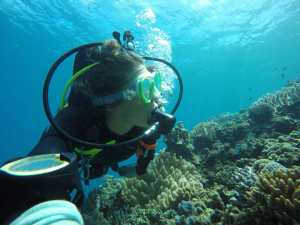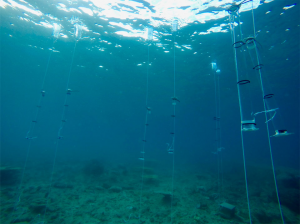CSUN Graduate Adds to Research on How Ocean Acidification Effects Coral Larvae
The species that live within a coral reef are as diverse as the plants and animals in a rain forest. Understanding humankind’s effects on marine life and the ecology of underwater ecosystems can help scientists better understand how to help coral reefs survive the coming century.

CSUN biology graduate alumnus Jessica Bergman, studying the corals in Okinawa, Japan. Photo Credit: Jessica Bergman
With the goal of contributing to coral reef research, California State University, Northridge biology alumna Jessica L. Bergman submitted her graduate thesis project, “Behavior of Brooded Coral Larvae in Response to Elevated pCO2,” to the National Science Foundation (NSF) East Asia Pacific Summer Institute (EAPSI). Her project focused on the behavior and physiology of coral larvae and how it is effected by ocean acidification.
“It’s particularly pleasing seeing CSUN graduate students achieving success by stepping onto a world where they are excelling,” said CSUN biology professor Peter Edmunds. “Jesse [Jessica] is a smart cookie who’s motivated and studied really hard. Jesse’s experience in Japan and through her [master of science] research can inspire other students to consider the same path.”
In 2016, she was awarded by NSF with an EAPSI summer fellowship and conducted her research with professor Saki Harii at Sesoko Research Station in Okinawa, Japan as part of the Tropical Biosphere Research Center, University of the Ryukyus.
“It was extremely enriching to link up with a lab across the world, not only because of the access to new resources, but because of the chance to experience a completely different culture by collaborating with Japanese students and researchers,” said Bergman. “Dr. Harii, as an expert in coral larval ecology, was also a great mentor that I continue to keep in touch with today.”
Ocean acidification is caused by the uptake of carbon dioxide in the atmosphere, and subsequently, its dissolution in seawater. According to Earth Eclipse, 30 to 40 percent of carbon dioxide from people dissolves into oceans, rivers and lakes.
“The human industry is producing carbon dioxide from power plants, cement manufacturers and driving cars and the carbon dioxide goes into the atmosphere and eventually dissolves into the seawater,” said Edmunds. “In seawater, carbon dioxide dissolves to create a weak acid, so in a future affected by ocean acidification, coral larvae probably will be living in slightly acidic water.”

The experimental setup in situ at Sesoko Station, with tubes marked for scoring larval movement. Photo Credit: Jessica Bergman
To conduct her study on how ocean acidification affected coral larvae, Bergman incubated coral larvae in three UV-transparent tubes on a shallow fringing reef, where they were monitored over a 24-hour period. She found that larvae were slightly more buoyant in acidic water.
According to Edmunds, the normal behavior of coral larvae involves the periodic movement of moving up and down in the seawater. When they move up to the surface, larvae encounter water moving at a different speed compared to greater depths. Bergman’s buoyancy results raise the question of whether these effects can influence the capacity of corals to replace themselves with baby corals.
“Coral larvae potentially can move from one reef to the next and repopulate a reef where large numbers of corals have been killed,” said Edmunds. “Larvae drift around with the currents, but eventually settle on the sea floor and glue themselves to rock where the conditions are favorable. Thereafter, they start growing and eventually and replace the adult corals. This is a slow process.”
According to National Ocean Service Education, the average growth rate of a coral reef is 0.3 to 2 centimeters per year. A hurricane can wipe out a coral reef overnight. If the rate of coral disappearance continues or rises, there are numerous potential negative outcomes, Edmunds said.
“In general, if coral larvae are exposed to the acid water, it makes the larvae go less far away from the reefs to produce them,” Edmunds continued. “Which might mean that they are less able to escape the conditions that are changing. The tricky part is that as conditions deteriorate everywhere, it’s possible that there won’t be anywhere to escape to.”
There are several reasons for why the disappearance of coral reefs is bad.
“Coral reefs prevent erosion of shorelines, and without coral reefs, you lose your costal protection,” said Edmunds. “For example, if you live in the Maldives, Marshall Islands or the Cayman, you live on an island that is maybe about 3 feet above sea level. If there’s no reef, you’re going to drown. The second reason for concern is that these [coral reefs] support a tourism industry worth hundreds of millions of dollars a year, and with no ref, much of this will go away.”
Without coral reefs, a source of fishery for the developing world is eliminated and scientists are not able research these species to find new antibiotics, cures and biomedical treasures said Edmunds.
The lowering of carbon dioxide levels in the atmosphere can decrease the acidity in ocean water. Bergman’s research sheds new light on the implications for the capacity of corals to replace themselves through reproduction.
For more information on Bergman’s research, please visit Frontiers in Marine Science website.

 experience
experience